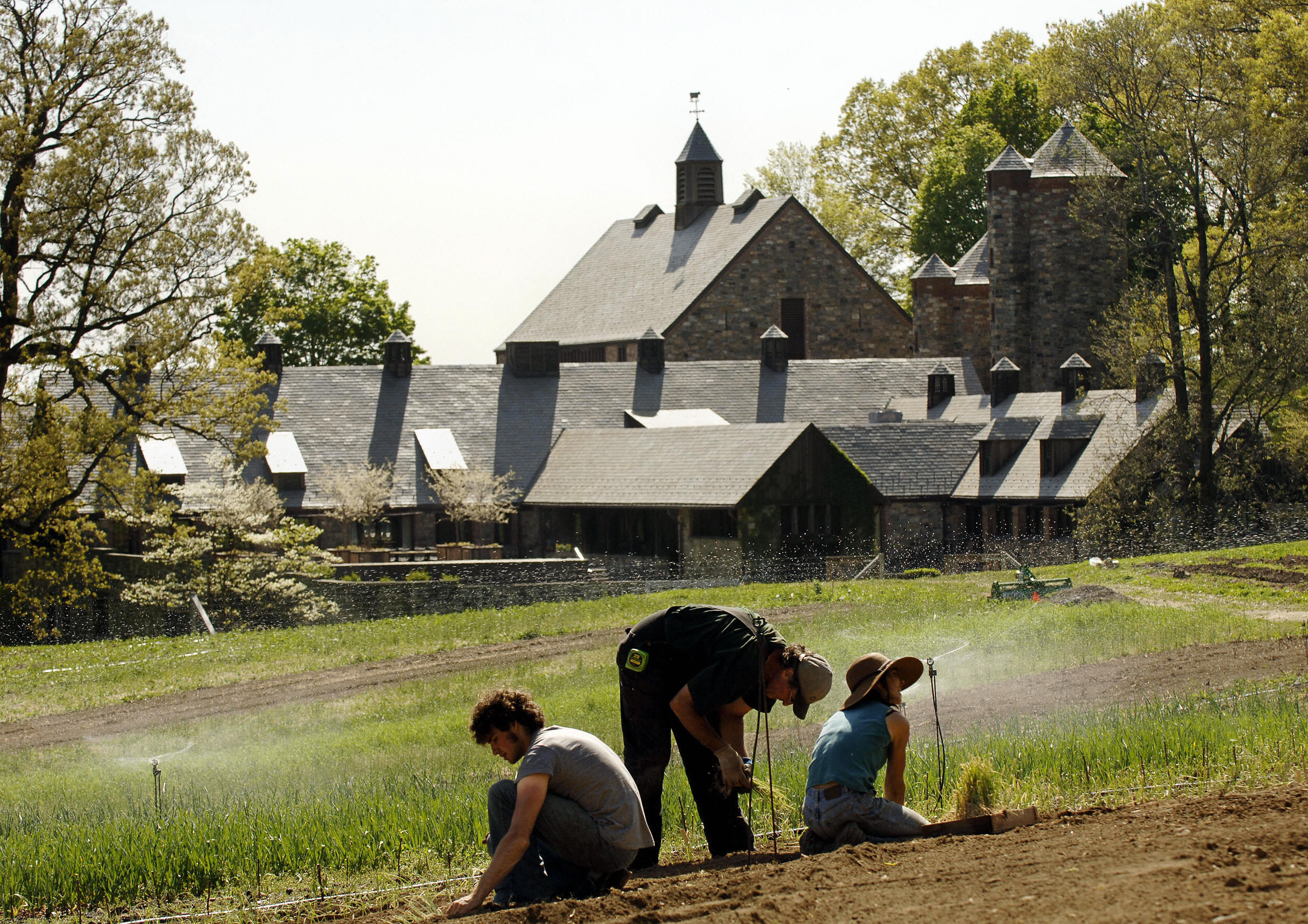The country has largely caught onto the fact that the bar and restaurant industries have been greatly imperiled by the coronavirus pandemic, with hundreds of thousands of small businesses and their tens of millions of employees representing a huge portion of the economic fallout. One lesser discussed factor to consider is the devastating impact which could be felt up and down the entire supply chain they’re a part of, including swaths of small, local farmers, producers and purveyors.
In one widely distributed interview with chef Dan Barber of Blue Hill Farm and Blue Hill at Stone Barns — aka the standard bearer for farm-to-table dining in America — it was reported that nearly 40 percent of 240 farmers surveyed believed they’d be at risk of bankruptcy due to the pandemic.
“The economic boom of the past 10 years, and the food generation of the past 35, has created a renewed revival of small, independent farms, because they had customers that they could sell to,” explains chef Andrew Zimmern, a founding member of the Independent Restaurant Coalition.
Still, in a research primer to the 2018 Farm Bill, the USDA reported that direct-to-consumer farm sales represented just .7 percent of the market. Factoring sales to retail markets, farmers markets, CSAs and other local or regional offerings into the total raises the figure to 3 percent. Meanwhile, of the 11,841 farms who participate in such ventures and are classified as local food farms, 85% percent make less than $75,000 in annual gross income.
“The shock of the COVID-19 crisis has disrupted the entire food chain, from restaurants all the way back to the farm,” says Evan Wiig, the director of membership and communications for the Community Alliance with Family Farmers, a California-based nonprofit organization. “For those farms that previously sold to such outlets like school and company cafeterias, wholesalers and, of course, restaurants, it’s been devastating.”
Working against farms in particular is the fact that they deal in perishables and are intrinsically tied to the seasons and what’s already in the ground; they can’t just pivot on a dime. “Most small family farms operate on razor-thin margins,” Wiig says. “One bad month can mean the difference between surviving into the next season or their business going under itself.”
These are the small producers working directly with your favorite chefs and restaurants to grow heirloom crops and quality, in-demand seasonal produce beyond what’s available on the mass market. These are the farmers who expand the breadth of what you can buy in your local market to reflect a diverse range of regional and seasonal offerings. And they’re in jeopardy.

With Risk Comes Opportunity
We’ve all seen the endless posts about people baking bread, growing starters and generally staying home and quaranbaking or quarancooking as much as possible. At the same time, grocery stores are sometimes depleted, or viewed as high-risk settings that some individuals seek to avoid. For all of these reasons, there’s been a surge of interest in CSAs.
“For those farms fortunate enough to have had pre-existing CSA models prior to the crisis, these are good times,” Wiig says. “Never in our 40 years of working to support these farms and CSA more generally have we seen a surge in membership like the one we’ve seen the past couple months.”
The other side to that coin is that farms who weren’t already operating under a CSA model can’t transition instantly, and even for those farms already engaged, they can’t scale up overnight to take advantage of a sudden surge or spike in demand. “It takes a lot of planning to operate a CSA farm, with production designed specifically to provide their members the perfect diversity of product in their weekly boxes all season long, whereas most other farmers specialize in just one or a small handful of crops,” Wiig says.
One solution has been a collaborative approach of farmers and producers coming together to meet a demand. “For instance, farms partnering or offering add-ons to their normal CSA: eggs, meat, honey and so forth,” Wiig says. “This kind of collaboration not only helps meet demand, but is a lifeline to those other farms. Meanwhile, there are also cooperatives of farmers working together to build produce boxes. FEED Sonoma is a good example, California’s first farmer- and employee-owned fresh produce cooperative.”
Just as supporting a CSA supports your local farmers, many restaurants have pivoted towards selling produce boxes and pantry items as well. By purchasing from them, you provide a double whammy, helping the restaurant and its employees, and their own down-the-line suppliers.
“Restaurants are a large part of the yearly income for many of these local and small purveyors and their fate is directly tied to restaurants,” says Steve Wong, director of operations at Oxalis in Brooklyn. “Because restaurants process their products and curate an experience, it is a symbiotic relationship to bring local product to consumers in a way that is easy.”
Oxalis is one of many restaurants who have been offering a thriving pantry and produce service, ranging from meal kits to market boxes and individual produce items. “By buying through our boxes, it’s helping these farms rebuild the ‘restaurant-portion’ of the revenue that they lost,” says Nico Russell, Oxalis’s executive chef. “We’re currently using the same purveyors that we were using before, and a lot of farmers have started working with them, such as Natoora, so it’s an easy way for us to work directly with farms.”
Purchasing pre-packaged kits from restaurants also lends the opportunity for more of an engaging or interactive meal, even if it’s at home. “We’ve worked to make our boxes as experiential as possible — we have felt that people could greatly benefit from some excitement to look forward to, such as our Date Night Kit,” Russell says, in which customers receive a curated multi-course meal with optional wine pairings. “The response online has been beyond our expectations! We receive tons of emails and calls from people expressing their appreciation that we’re working to help brighten up their weeks. We are so grateful for all of their support.”

The Need for Change
It’s laudable to support CSAs, restaurants-cum-grocers and all similar ventures — and we emphasize that you absolutely should! But as mentioned above, the segment is a tiny fraction of the agricultural market. There’s a need for larger, more sweeping changes. “I think the biggest concern is our food system,” says chef José Andrés, restaurateur and founder of World Central Kitchen. “We are now seeing how broken it is, how hungry people are. We need to create systems so that if this kind of situation happens again, there is a place for people to fall back, to be able to get food safely and affordably.”
His organization has served more than 10 million meals in response to the pandemic as of early June, cranking them out to a tune of 300,000 per day. “We have families and communities who are unable to access food in some places, and terrible waste in others, why is this so complicated, people?” Andrés wonders. And more to the point, if WCK can accomplish that on their own, what could a properly-financed and organized government program accomplish?
In April, the USDA announced a plan to purchase $3 billion of produce, dairy and meat products, with a planned $300 million/month outlay. The goods would be provided to food banks and nonprofit organizations. It’s a commendable effort, and in effect is a sort of government-subsidized CSA serving in-need communities. Though one wonders why such a program, or even a larger scale version of one, wasn’t already a permanent part of how we care for the country. It’s an effective way to accomplish multiple goals with one directive, potentially helping thousands of small farmers thrive while making a real dent into pervasive food scarcity and hunger issues.
Further, a thriving industry of small farmers and producers is hugely important, not only for their own economic wellbeing, but for the health of the food system as a whole. Look no further than the news reports we’ve seen over the past few months, with meat shortages due to plant closures, mass slaughtering of animals which can’t be processed or sold, millions of gallons of milk being dumped, and more.
“The crime of the last 70 years, since the ’50s, has been the slow centralization of our food system,” Zimmern says. “The reason we’re having so many problems over the last couple of weeks in pork and beef plants is that with beef, 75 or 85 percent of the product is controlled by three companies. Pork, I think, it’s 65 or 75 percent controlled by three or four companies. We have to decentralize that so we prevent food-borne illness, human virus … and it’s a national security issue, if someone were to get into poison that system.”
There are ways you can be supportive at home. Consider joining a CSA, frequenting local farmers markets, many of which are now offering online ordering and options such as curbside pickup, and buying produce and meal kits from your favorite restaurants. But it’s also time to advocate for bigger change, too.
“We must be setting up systems to make these connections in a simple way, to be making sure that people can get the food that they need,” Andrés says. “We need to be asking ourselves, the White House, Congress, how can we be using food as part of the solution?”
Whether that solution will arrive early enough to save an industry in peril remains to be seen.
Every Thursday, our resident experts see to it that you’re up to date on the latest from the world of drinks. Trend reports, bottle reviews, cocktail recipes and more. Sign up for THE SPILL now.






















